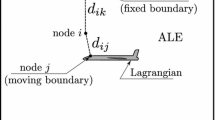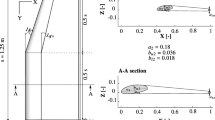Abstract
In this paper, we present a computational aeroelastic analysis of flexible flapping wings in the vicinity of solid walls. The wall effects change the aerodynamic forces and moments of the wings, and thus the aeroelastic behavior. The numerical simulation is carried out using a fluid–structure interaction framework by coupling the computational fluid dynamics and computational structural dynamics. A preconditioned Navier–Stokes solver based on a finite volume method is used for the aerodynamic analysis. The structural analysis is performed using a nonlinear structural model based on a geometrically exact beam formulation. The method is validated using previous numerical and experimental results. The aeroelastic characteristics of the flexible wings with and without the walls are computed and compared.


















Similar content being viewed by others
Abbreviations
- C L :
-
Lift coefficient
- C *L :
-
Sectional lift coefficient
- C T :
-
Thrust coefficient
- C *T :
-
Sectional thrust coefficient
- c :
-
Wing chord length
- e :
-
Specific total energy
- L :
-
Lift
- T x :
-
Thrust
- n :
-
Unit normal vector
- p :
-
Pressure
- T :
-
Temperature
- T:
-
Period of a plunging motion
- u :
-
Velocity component in the x direction
- v :
-
Velocity component in the y direction
- w :
-
Velocity component in the z direction
- ρ :
-
Density
- Ω :
-
Angular velocity
References
Bohorquez F, Samuel P, Sirohi J, Pines D, Rudd L, Perel R (2003) Design, analysis and hover performance of a rotary wing micro air vehicle. J Am Helicopter Soc 48:80–90
Ansari SA, Zbikowski R, Knowles K (2006) Aerodynamic modelling of insect-like flapping flight for micro air vehicles. Progr Aerosp Sci 42(2):129–172
Woods MI, Henderson JF, Lock GD (2001) Energy requirements for the flight of micro air vehicles. Aeronaut J 105(1045):135–149
Shkarayev S, Silin D (2009) Aerodynamics of flapping-wing micro air vehicles. In: 47th AIAA aerospace sciences meeting including the new horizons forum and aerospace exposition, AIAA paper 2009-878
Lee J-S, Kim D-K, Lee J-Y, Han J-H (2008) Experimental evaluation of a flapping wing aerodynamic model for MAV application. In: Proceedings of SPIE, San Diego, pp 69282 M-1–69282 M-8
Lesage F, Hamel N (2008) Aerodynamic study of a flapping-wing NAV using a combination of numerical and experimental methods. In: 26th AIAA applied aerodynamics conference, AIAA paper 2008-6396
Zhang Y, Ye Z, Xie F (2012) Computational investigation of a doubly hinged flapping airfoil. AIAA J 50(12):2643–2654
Takizawa K, Henicke B, Puntel A, Kostov N, Tezduyar TE (2013) Computer modeling techniques for flapping-wing aerodynamics of a locust. Comput Fluids 85:125–134
Taira K, Colonius T (2009) Three-dimensional flows around low-aspect-ratio flat-plate wings at low Reynolds numbers. J Fluid Mech 623:187–207
Lian Y, Shyy W (2007) Laminar-turbulent transition of a low Reynolds number rigid or flexible airfoil. AIAA J 45(7):1501–1513
Viieru D, Tang J, Lian Y, Liu H, Shyy W (2006) Flapping and flexible wing aerodynamics of low Reynolds number flight vehicles. In: 44th AIAA aerospace sciences meeting and exhibit, AIAA paper 2006-503
Heathcote S, Gursul I (2007) Flexible flapping airfoil propulsion at low Reynolds numbers. AIAA J 45(5):1066–1079
Hamamoto M, Ohta Y, Hara K, Hisada T (2007) Application of fluid-structure interaction analysis to flapping Flight of insects with deformable wings. Adv Robot 21(1-2):1–21
Gursul I, Cleaver DJ, Wang Z (2014) Control of low Reynolds number flows by means of fluid-structure interactions. Progr Aerosp Sci 64:17–55
Heathcote S, Wang Z, Gursul I (2008) Effect of spanwise flexibility on flapping wing propulsion. J Fluids Struct 24:183–199
Chimakurthi SK (2009) A computational aeroelasticity framework for analyzing flapping wings. Ph.D. Dissertation, Department of Aerospace Engineering, The University of Michigan
Aono H, Chimakurthi SK, Cesnik CES, Liu H, Shyy W (2009) Computational modeling of spanwise flexibility effects on flapping wing aerodynamics. In: 47th AIAA aerospace sciences meeting including the new horizons forum and aerospace exposition, AIAA paper 2009-1270
Gordnier RE, Chimakurthi SK, Cesnik CES, Attar PJ (2013) High-fidelity aeroelastic computations of a flapping wing with spanwise flexibility. J Fluids Struct 40:86–104
Cho H, Kwak JY, Shin SJ, Lee N, Lee S (2014) A computational analysis for flapping wing by coupling the geometrically exact beam and preconditioned Navier–Stokes solution. In: 55th AIAA/ASME/ASCE/AHS/ASC structures, structural dynamics, and materials conference, AIAA paper 2014-1519
Lee N, Lee S, Cho H, Kwak JY, Shin SJ (2014) Computational analysis for flapping wing by coupled CFD and CSD solutions. In: 29th congress of the international council of the aeronautical sciences
Rae WH, Pope A (1984) Low-speed wind tunnel testing, 2nd edn. Wiley, New York
Lian Y (2009) Numerical investigation of boundary effects on flapping wing study. In: 47th AIAA aerospace sciences meeting including the new horizons forum and aerospace exposition, AIAA paper 2009-539
Igarashi H, Durbin PA, Hu H, Waltermire S, Wehrmeyer J (2011) The effects of wind tunnel walls on the near-field behavior of a wingtip vortex. In: 49th AIAA aerospace sciences meeting including the new horizons forum and aerospace exposition, AIAA paper 2011-1165
Maeda M, Liu H (2013) Ground effect in fruit fly hovering: a three-dimensional computational study. J Biomech Sci Eng 8(4):344–355
Quinn DB, Moored KW, Dewey PA, Smits AJ (2014) Unsteady propulsion near a solid boundary. J Fluid Mech 742:152–170
Zhang X, Lua KB, Chang R, Lim TT, Yeo KS (2014) Experimental study of ground effect on three-dimensional insect-like flapping motion. Int J Mod Phys Conf Ser 34:1460384
Weiss JM, Smith WA (1995) Preconditioning applied to variable and constant density flows. AIAA J 33(11):2050–2057
Roe PL (1981) Approximate Riemann solvers, parameter vectors, and difference schemes. J Comput Phys 43:357–372
van Leer B (1979) Towards the ultimate conservative difference scheme V. A second order sequel to Godunov’s method. J Comput Phys 32:101–136
Rendall TCS, Allen CB (2008) Unified fluid-structure interpolation and mesh motion using radial basis functions. Int J Numer Methods Eng 74(10):1519–1559
Schaback R, Wendland H (2000) Adaptive greedy techniques for approximate solution of large RBF systems. Numer Algorithms 24(3):239–254
Thomas PD, Lombard CK (1979) Geometric conservation law and its application to flow computations on moving grids. AIAA J 17(10):1030–1037
Hodges DH (1990) A mixed variational formulation based on exact intrinsic equations for dynamics of moving beams. Int J Solids Struct 26(11):1253–1273
Shang X (1995) Aeroelastic stability of composite hingeless rotors with finite-state unsteady aerodynamics. Ph. D. Dissertation, Georgia Institute of Technology
Cheng T (2002) Structural dynamics modeling of helicopter blades for computational aeroelasticity. M.S. Thesis, Massachusetts Institute of Technology
Bauchau OA (2006) DYMORE users’ manual, school of aerospace engineering. Georgia Inst. of Technology, Atlanta
Liu P, Bose N (1963) Propulsive performance from oscillating propulsors with spanwise flexibility. Proc R Soc A Math Phys Eng Sci 1997(453):1763–1770
Jeong J, Hussain F (1995) On the identification of a vortex. J Fluid Mech 285:69–94
Shyy W, Trizila P, Kang C-K, Aono H (2009) Can tip vortices enhance lift of a flapping wing? AIAA J 47(2):289–293
Acknowledgements
This work was supported by Inha University and the National Research Foundation of Korea Grant funded by the Korean Government (2011-0029094).
Author information
Authors and Affiliations
Corresponding author
Additional information
Publisher's Note
Springer Nature remains neutral with regard to jurisdictional claims in published maps and institutional affiliations.
Rights and permissions
About this article
Cite this article
Lee, N., Lee, S., Cho, H. et al. A Computational Study of Wall Effects on the Aeroelastic Behavior of Spanwise Flexible Wings. Int. J. Aeronaut. Space Sci. 20, 596–610 (2019). https://doi.org/10.1007/s42405-019-00168-3
Received:
Revised:
Accepted:
Published:
Issue Date:
DOI: https://doi.org/10.1007/s42405-019-00168-3




